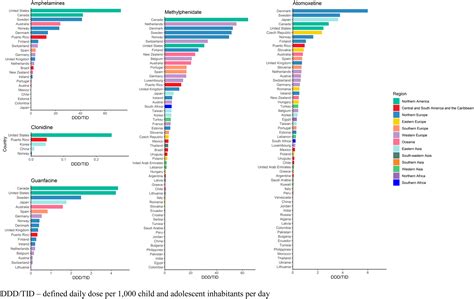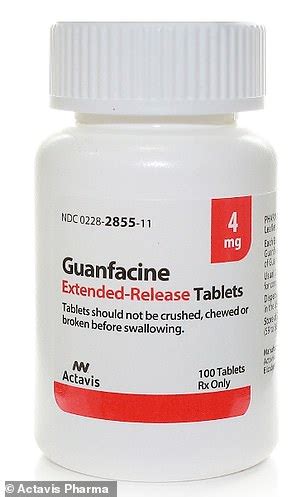Intro
Discover how Guanfacine works as an alpha-2 adrenergic agonist, treating ADHD and hypertension by regulating neurotransmitters, improving focus, and reducing blood pressure, with its mechanism of action and effects on the brain and body.
Guanfacine is a medication that has been widely used to treat attention deficit hyperactivity disorder (ADHD) and high blood pressure. Understanding how guanfacine works is essential to appreciating its benefits and potential side effects. Guanfacine belongs to a class of medications known as alpha-2 adrenergic agonists, which work by stimulating certain receptors in the brain. This stimulation has a calming effect on the brain, leading to improved attention and reduced impulsivity and hyperactivity in individuals with ADHD.
The mechanism of action of guanfacine involves its ability to selectively bind to alpha-2A adrenergic receptors in the brain. These receptors are primarily found in the prefrontal cortex, an area responsible for executive function, working memory, and attention. By activating these receptors, guanfacine increases the release of norepinephrine, a neurotransmitter that plays a crucial role in attention and impulse control. The increased norepinephrine levels enhance the functioning of the prefrontal cortex, leading to improved focus, reduced distractibility, and better impulse control.
Guanfacine's effectiveness in managing ADHD symptoms has been demonstrated in numerous clinical trials. These studies have shown that guanfacine can significantly reduce symptoms of inattention and hyperactivity-impulsivity, leading to improved overall functioning and quality of life for individuals with ADHD. Moreover, guanfacine has been found to have a favorable safety profile, with common side effects being mild and transient. The unique mechanism of action of guanfacine, combined with its efficacy and safety profile, makes it a valuable treatment option for ADHD.
Benefits of Guanfacine

The benefits of guanfacine extend beyond its ability to manage ADHD symptoms. It has also been found to have a positive impact on sleep quality, which is often impaired in individuals with ADHD. Improved sleep quality can have a cascading effect on overall health and well-being, leading to better mood regulation, enhanced cognitive function, and reduced stress levels. Furthermore, guanfacine has been shown to have a potential role in managing anxiety and stress, which are common comorbidities with ADHD. By reducing anxiety and stress levels, guanfacine can help individuals with ADHD to better cope with daily challenges and improve their overall quality of life.
In addition to its therapeutic benefits, guanfacine has several advantages over other ADHD medications. It has a longer duration of action, which means that it can provide symptom relief for an extended period, typically 24 hours. This can lead to improved adherence to treatment, as individuals with ADHD may find it easier to remember to take their medication once daily. Guanfacine also has a lower potential for abuse compared to stimulant medications, which are commonly used to treat ADHD. This makes guanfacine a safer option for individuals who may be at risk of substance abuse.
Working Mechanism of Guanfacine
The working mechanism of guanfacine involves its ability to stimulate alpha-2 adrenergic receptors in the brain. This stimulation leads to an increase in the release of norepinephrine, which enhances the functioning of the prefrontal cortex. The prefrontal cortex is responsible for executive function, working memory, and attention, and improved functioning of this area leads to better focus, reduced impulsivity, and enhanced cognitive control.The stimulation of alpha-2 adrenergic receptors by guanfacine also has a calming effect on the brain, which can help to reduce anxiety and stress levels. This calming effect is thought to be mediated by the increased release of norepinephrine, which can help to regulate the body's stress response. By reducing anxiety and stress levels, guanfacine can help individuals with ADHD to better cope with daily challenges and improve their overall quality of life.
Steps to Take Guanfacine

To take guanfacine effectively, it is essential to follow the prescribed dosage and administration instructions. Guanfacine is typically taken once daily, in the morning, and should be swallowed whole with water. It is essential to take guanfacine at the same time every day to maintain a consistent level of the medication in the body.
The dosage of guanfacine will depend on the individual's response to the medication and their overall health status. The recommended starting dose is typically 1-2 mg, which can be gradually increased to a maximum dose of 4-6 mg per day. It is essential to work closely with a healthcare provider to determine the optimal dosage and to monitor for any potential side effects.
In addition to following the prescribed dosage and administration instructions, there are several steps that individuals can take to maximize the effectiveness of guanfacine. These include:
- Establishing a consistent daily routine, including a regular sleep schedule and meal times
- Engaging in regular physical activity, such as exercise or sports
- Practicing stress-reducing techniques, such as meditation or deep breathing
- Avoiding caffeine and other stimulants, which can interact with guanfacine
By following these steps and working closely with a healthcare provider, individuals can maximize the benefits of guanfacine and improve their overall quality of life.
Practical Examples of Guanfacine Use
Guanfacine has been used to treat ADHD in individuals of all ages, from children to adults. In children, guanfacine has been shown to be effective in reducing symptoms of inattention and hyperactivity-impulsivity, leading to improved academic performance and social functioning.In adults, guanfacine has been used to treat ADHD, as well as anxiety and stress. It has been found to be effective in reducing symptoms of anxiety and stress, leading to improved mood regulation and overall well-being.
For example, a 10-year-old boy with ADHD may be prescribed guanfacine to help manage his symptoms of inattention and hyperactivity-impulsivity. With the help of guanfacine, he may be able to focus better in school, complete his homework on time, and engage in social activities with his peers.
Similarly, a 35-year-old woman with ADHD and anxiety may be prescribed guanfacine to help manage her symptoms. With the help of guanfacine, she may be able to reduce her anxiety and stress levels, leading to improved mood regulation and overall well-being.
Statistical Data on Guanfacine

Numerous studies have demonstrated the effectiveness of guanfacine in managing ADHD symptoms. According to a meta-analysis of 13 clinical trials, guanfacine was found to be effective in reducing symptoms of inattention and hyperactivity-impulsivity in individuals with ADHD.
The study found that guanfacine was associated with a significant reduction in ADHD symptoms, with a moderate to large effect size. The study also found that guanfacine was well-tolerated, with common side effects being mild and transient.
Another study published in the Journal of Attention Disorders found that guanfacine was effective in improving sleep quality in individuals with ADHD. The study found that guanfacine was associated with a significant improvement in sleep quality, with participants reporting improved sleep duration and reduced sleep disturbances.
These studies demonstrate the effectiveness of guanfacine in managing ADHD symptoms and improving overall quality of life. By providing a comprehensive overview of the benefits and working mechanism of guanfacine, individuals with ADHD can make informed decisions about their treatment options and work closely with their healthcare providers to maximize the benefits of guanfacine.
Common Side Effects of Guanfacine
While guanfacine is generally well-tolerated, it can cause some common side effects. These include:- Drowsiness or fatigue
- Headache
- Nausea or stomach upset
- Dizziness or lightheadedness
- Constipation
These side effects are typically mild and transient, and may resolve on their own within a few days of starting treatment. However, if side effects persist or worsen, it is essential to consult with a healthcare provider.
In rare cases, guanfacine can cause more serious side effects, such as:
- Hypotension (low blood pressure)
- Bradycardia (slow heart rate)
- Syncope (fainting)
- Allergic reactions
If any of these side effects occur, it is essential to seek medical attention immediately.
Conclusion and Future Directions

In conclusion, guanfacine is a valuable treatment option for ADHD, with a unique mechanism of action and a favorable safety profile. By stimulating alpha-2 adrenergic receptors in the brain, guanfacine can help to reduce symptoms of inattention and hyperactivity-impulsivity, leading to improved overall functioning and quality of life.
Future directions for guanfacine research include investigating its potential role in managing anxiety and stress, as well as its use in combination with other medications to treat complex psychiatric disorders. Additionally, further studies are needed to fully understand the long-term effects of guanfacine and to identify potential biomarkers for treatment response.
As research continues to uncover the benefits and mechanisms of guanfacine, it is essential for individuals with ADHD to work closely with their healthcare providers to determine the best treatment options for their unique needs. By staying informed and up-to-date on the latest research and developments, individuals with ADHD can maximize the benefits of guanfacine and improve their overall quality of life.
Final Thoughts
Guanfacine is a medication that has been widely used to treat ADHD and high blood pressure. Its unique mechanism of action and favorable safety profile make it a valuable treatment option for individuals with ADHD. By understanding how guanfacine works and its potential benefits and side effects, individuals with ADHD can make informed decisions about their treatment options and work closely with their healthcare providers to maximize the benefits of guanfacine.We invite you to share your thoughts and experiences with guanfacine in the comments section below. Have you or a loved one used guanfacine to treat ADHD or high blood pressure? What were your experiences with the medication? Share your stories and help others who may be considering guanfacine as a treatment option.
What is guanfacine used to treat?
+Guanfacine is used to treat attention deficit hyperactivity disorder (ADHD) and high blood pressure.
How does guanfacine work?
+Guanfacine works by stimulating alpha-2 adrenergic receptors in the brain, which leads to an increase in the release of norepinephrine and improved attention and impulse control.
What are the common side effects of guanfacine?
+Common side effects of guanfacine include drowsiness, headache, nausea, dizziness, and constipation.
Can guanfacine be used in combination with other medications?
+Yes, guanfacine can be used in combination with other medications to treat complex psychiatric disorders. However, it is essential to consult with a healthcare provider before taking any new medications.
Is guanfacine safe for children and adults?
+Guanfacine is generally safe for children and adults when taken as directed. However, it is essential to follow the prescribed dosage and administration instructions and to consult with a healthcare provider if any side effects occur.
